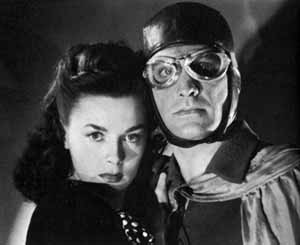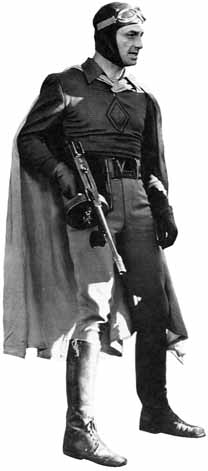|

Kane Richmond and Marguerite Chapman
in Spy Smasher.
But it’s not just the cliffhanger that makes Chapter One a brisk barrage of excitement. The chapter’s emphasis is all action. We don’t get needless exposition setting things up, but like a catchy comic book splash page highlighting a fist fight, this chapterplay throws us directly into its good vs. evil dialectic. Spy Smasher (Kane Richmond as Allan Armstrong, American freelance agent in occupied France), stealthily walks through a Nazi headquarters in Paris. Suddenly he’s kicking a Nazi and then throwing punches on the stairs. He’s captured, tortured in a smoked-filled underground room, and then ordered executed, firing-squad style. Bullets pop in the wall next to him, he falls, but as he’s placed in a coffin he smiles at Pierre Durand, a Vichy officer who’s more free French than Vichy (seems Durand had switched most of the bullets for blanks!). Back in the US, the plot gets even more complicated as a Nazi suddenly jumps Armstong on a train. Armstrong has no idea what’s going on because he’s not the Spy Smasher, but Allan’s twin brother, Jack! Spy Smasher, hurrying along the top of the train, hears the ruckus, drops in, helps his brother, and hurls the Nazi from the train. And all of this happens before the first cliffhanger!
The square-jawed Kane Richmond was probably a boy’s idea of a hero. He’s reserved, strong, and not at all interested in girls. He walks with shoulders back and speaks with clipped confidence. By contrast, twin brother Jack, seems younger, his shoulders are stooped, his voice higher, his walk more of a slender shrug. Richmond’s ability to create differences between these two characterizations is one of the film’s charms, and perhaps boys enjoyed the dichotomy between how they saw themselves (shy Jack) and what they wanted to become (confident Allan). Moreover, Spy Smasher, unlike Superman, was an ordinary guy that ordinary guys could identify with. His fight against the Nazis, during the early dark days of World War II when American casualties in the South Pacific were high, provided boys with the heroism that they and the country needed. And, no doubt, identification was made easier by Spy Smasher’s basic costume—aviator’s hat, goggles, leather jacket and scarf—that could be easily imitated by his young fans.

Kane Richmond gets interrogated in Spy Smasher.
Richmond has the same earnest believability of "Buster" Crabbe’s Flash Gordon, but it’s Witney who’s the real star of this serial. He continues to thwart our expectations with innovations and staggering tricks. In Chapter Two, it looks like Spy Smasher is machine-gunned to death, but in Chapter Three’s resolution, we discover that our hero switched his clothes with a knocked-out Nazi. In Chapter Three, it appears that Spy Smasher drowns in the torpedo room of the Mask’s submarine—that notorious no-gooder opened the valves! But in the resolution, we discover that Pierre Durand, finding only one aqua-lung, places it on our hero, shoves him out through the torpedo bay doors, and sacrifices himself for the cause. But the biggest surprise occurs in Chapter Eleven’s cliffhanger. Spy Smasher, in an attempt to rescue Eve Corby (Howard Hughes discovery, Marguerite Chapman), crashes in on television reporter Drake (the Mask’s lieutenant) and fellow baddies. He distracts them with a rooftop fight, while she hurries down a fire escape. But when they unload their guns, he takes several rounds to the chest, flinches, and falls over the edge. On the street, Eve screams as Spy Smasher hits the pavement with a hollow thud. How can he possibly escape this one?
(SPOILERS ahead.) He doesn’t. He’s dead! In the final chapter, "V . . . —", we discover more of Witney’s genius. It was brother Jack, not the real Spy Smasher, who knocked his brother unconscious and donned the costume to rescue his fiancee, Eve. In Chapter Eleven, Jack finds Eve missing and five keys indented on her typewriter. Combining the letters, he spells out the clue: "Drake" has her. Jack wants to rescue his love, but Allan says, "No. This is my job. They want Spy Smasher, they’ll get him." He taps his brother’s shoulder twice, says not to worry and exits the frame. Jack, alone in the shot, grimaces, and moves toward the offscreen Allan. A wipe follows. What’s missing in that wipe is what gets filled in in Chapter Twelve. Jack realizes Allan’s importance to his country and ends up sacrificing himself. Witney, through the ellipsis of the wipe, cleverly holds back information. His surprises aren’t only contained within cliffhangers and their resolutions, but in the very machinations that lead to the cliffhanger!
Republic didn’t compete with the other studios for the top comic-book and pulp fictional superheroes. Fawcett Publications’ Spy Smasher, wasn’t the equal, in terms of audience recognition, of Universal’s Flash Gordon (1936) or Columbia’s The Shadow (1940), and that studio’s future adaptations of National Comics’ top-selling Batman (1943) or Superman (1948). But the other studios didn’t have Witney. And in his hands, Spy Smasher rises above them all.
The Serials: An Introduction
Page 1: In the Theaters
Page 2: The Beginnings
Page 3: Enter Flash Gordon
Page 4: The Golden Age
Page 5: The Downfall
The Phantom Empire
Flash Gordon
Dick Tracy
The Fighting Devil Dogs
Zorro's Fighting Legion
The Shadow
Mysterious Dr. Satan
Spy Smasher
Perils of Nyoka
The Tiger Woman
Serials Web Links
|

 William Witney’s Spy Smasher, like his later Perils of Nyoka, is perhaps one of the best serials of all time because of its stunning cliffhangers and unique innovations to the serial form.
William Witney’s Spy Smasher, like his later Perils of Nyoka, is perhaps one of the best serials of all time because of its stunning cliffhangers and unique innovations to the serial form.


